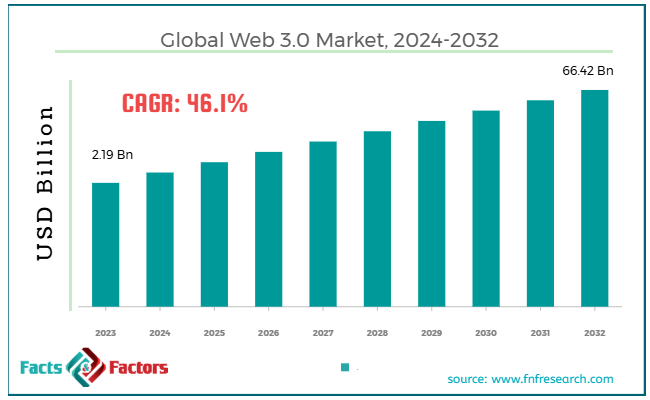Search Market Research Report
Web 3.0 Market

Web 3.0 Market Size, Share, Growth Analysis Report By Blockchain Type (Public, Private, Consortium, Hybrid), By Application (Cryptocurrency, Conversational AI, Data & Transaction Storage, Payments, Smart Contracts, and Others), By End Use (BFSI, Retail & E-commerce, Media & Entertainment, Pharmaceuticals, IT & Telecom, and Others), And By Region - Global Industry Insights, Overview, Comprehensive Analysis, Trends, Statistical Research, Market Intelligence, Historical Data and Forecast 2024 – 2032
Industry Insights
[216+ Pages Report] According to Facts & Factors, the global web 3.0 market size was worth around USD 2.19 billion in 2023 and is predicted to grow to around USD 66.42 billion by 2032, with a compound annual growth rate (CAGR) of roughly 46.1% between 2024 and 2032.

 Market Overview
Market Overview
Web 3.0, aka decentralized web, is the next progression of the internet, wherein individuals have improved control of their online transactions and data. It uses technologies like cryptocurrencies, blockchain, and decentralized applications. This allows peer-to-peer communications without needing intermediaries. This enables enhanced privacy, user empowerment, and transparency.
The global Web 3.0 market is propelled by key drivers like the growth of cryptocurrency & blockchain and user control and decentralization. The growth of blockchain technologies that offer transparent, secure, and decentralized transactions has fueled the market growth.
Blockchain supports several web 3.0 characteristics, comprising NFTs, DeFi, and digital assets, motivating investment and innovations in the space. Another prominent driver of the market is the demand for optimum control of personal data. Unlike centralized platforms, web 3.0 assures decentralization, where users can communicate without intermediaries.
Nonetheless, despite these drivers, the global market faces obstacles like scalability challenges and regulatory uncertainty. Several blockchain networks witness restrictions regarding costs and speeds. For instance, Ethereum has struggled with significant gas fees and congestion, which hampers the broader adoption of Web 3.0.
Moreover, the regulatory ambiance for Web 3.0 technologies, mainly cryptocurrencies is still progressing. Though governments are making efforts to strengthen regulations of decentralized technologies, concerns about illegal activities, such as fraud and money laundering, may limit the adoption.
Yet, the market is opportune to the prominence of decentralized finance like borrowing, lending, and trading without requiring traditional banks. This progressing domain is disturbing financial systems and providing fresh investment avenues.
Also, the progressing NFTs market has transformed industries like entertainment, gaming, and art. Web 3.0 offers ways to create and trade digital assets with verifiable ownership, creating major opportunities for investors and creators.
 Key Insights:
Key Insights:
- As per the analysis shared by our research analyst, the global Web 3.0 market is estimated to grow annually at a CAGR of around 46.1% over the forecast period (2024-2032)
- In terms of revenue, the global Web 3.0 market size was valued at around USD 2.19 billion in 2023 and is projected to reach USD 66.42 billion by 2032.
- The Web 3.0 market is projected to grow substantially owing to enhanced security and privacy, the increasing adoption of AI and ML, and the rising use of augmented and virtual reality.
- Based on blockchain type, the public segment is the dominating segment among others, while the hybrid segment is projected to witness sizeable revenue over the forecast period.
- Based on application, the cryptocurrency segment is expected to lead the market, while the smart contracts segment is expected to register considerable growth.
- Based on end use, the BFSI segment is expected to lead the market as compared to the retail and e-commerce segments.
- Based on region, North America is projected to dominate the global market during the estimated period, followed by Asia-Pacific.
 Growth Drivers
Growth Drivers
- The emergence of cryptocurrency and blockchain positively impact the Web 3.0 market
Cryptocurrencies and blockchain technology are the core components of Web 3.0. Blockchain provides transparent, decentralized, and secure systems for managing transactions and data, while cryptocurrencies offer an economic coating that supports DeFi and tokenization.
In 2024, Ethereum, the prominent blockchain platform for decentralized apps, exceeded USD 50 billion in TVL (total value locked). This underscored the rise of decentralized finance in Web 3.0, thus impacting the growth of the Web 3.0 market.
Bitcoin is still a major player with a total industry cap surpassing USD 500 billion in the past year, thus strengthening the economic infrastructure for Web 3.0.
In January 2025, Bitcoin touched the highest of above USD 75,000 for each coin. This was followed by the institutional implementation that continued its growth with hedge funds and key financial institutions integrating cryptocurrencies in assortments.
- The growing integration of ML and AI is the key propellant of the market
Web 3.0 is also classified by the incorporation of machine learning and artificial intelligence to enhance user experience, automate tasks in decentralized networks, and allow smart data processing. The amalgamation of blockchain and AI is supporting to create more personalized, smarter, and effective decentralized applications.
merging of AI and blockchain is increasing its evidence in fields like data marketplaces. AI-based platforms are already using decentralized systems to allocate tasks for ML models, allowing secure and transparent data-sharing environments.
Released in 2024, Open AI’s GPT-4 is now incorporated in web 3.0 platforms for smart contract development, automating decentralized content creation, and enhanced user interaction.
Furthermore, a decentralized oracle network, Chainlink recently launched Chainlink AI. This brings data analysis and machine learning to blockchain networks, thus aiding more effective and modernized smart contract execution in Web 3.0 networks.
 Restraints
Restraints
- Regulatory uncertainty poses challenges for the Web 3.0 market progress
The regulatory environment for Web 3.0 solutions, mainly for decentralized finance and cryptocurrencies is still in progress. Regulatory ambiguity brings challenges for investors and businesses who are looking for extended stability in the Web 3.0 space. Financial authorities and governments are still dealing with ways to regulate and define decentralized networks, which might affect the progress of Web 3.0.
In the present scenario, just 10 percent of the global jurisdictions have completely adopted regulations for cryptocurrencies, while 51% have still not developed a regulatory framework, and 39% are still exploring.
In 2023, the United States (SEC) labeled multiple tokens, comprising Luna and XRP, as securities, activating legal battles that complained about the upcoming DeFi token offerings and projects.
Also, the EU’s Markets in Crypto-Assets Regulation, anticipated to be imposed by 2025, will offer clear regulations for crypto businesses, but many are concerned over the strict rules that might restrict modernization in decentralized technologies.
 Opportunities
Opportunities
- The growing popularity of virtual worlds and the metaverse positively impact the Web 3.0 market
The metaverse, an interlinked virtual design on Web 3.0 technologies is speedily gaining popularity as a prospect for businesses and individuals. The metaverse is a consistent virtual world wherein users can communicate, socialize, purchase virtual products, work, and play games. Web 3.0 solutions allow the decentralization of Metaverse, offering ownership of assets to users in the virtual worlds through blockchain NFTs and tokens.
Microsoft declared an association with META in 2024, to design enterprise solutions for Metaverse with the help of Web 3.0. the aim was to create virtual workspaces and collective environments that might be incorporated with NFT and blockchain functionality.
Furthermore, Gucci and Nike have begun selling digital products in the metaverse, shaping the fashion industry’s key steps in virtual space.
 Challenges
Challenges
- Consumer adoption and education are key obstacles to the Web 3.0 market growth
Education and user adoption are the major barriers to Web 3.0, which hinders the growth of the Web 3.0 industry. A majority of users are not versed with cryptocurrency, blockchain, and decentralized applications, and a need to manage secure private keys. For Web 3.0 to touch mainstream adoption, training users on these solutions and providing a simple-to-use interface will be essential.
In 2023, Meta introduced a web 3.0 wallet on IG (Instagram), helping users communicate with digital assets and NFTs in the application. This signals an effort to educate average consumers on Web 3.0 solutions in a friendly way.
Coinbase still emphasizes enhancing accessibility, stating in 2024 that it streamlined the process of holding and purchasing NFTs on its platform to increase the accessibility of Web 3.0 for mainstream individuals.
In 2024, Apple declared plans to create educational tools to support developers to make web 3.0-native applications. They also introduced an initiative to train blockchain development via its programming sessions, with the aim of raising a new group of web 3.0 talent.
 Report Scope
Report Scope
Report Attribute |
Details |
Market Size in 2023 |
USD 2.19 Billion |
Projected Market Size in 2032 |
USD 66.42 Billion |
CAGR Growth Rate |
46.1% CAGR |
Base Year |
2023 |
Forecast Years |
2024-2032 |
Key Market Players |
Ethereum, Polkadot, Solana, Chainlink, Filecoin, Uniswap, Aave, OpenSea, Binance, Cardano, Chainalysis, Metamask, Dapper Labs, NFTfi, MakerDAO, and Others. |
Key Segment |
By Blockchain Type, By Application, By End Use, and By Region |
Major Regions Covered |
North America, Europe, Asia Pacific, Latin America, and the Middle East &, Africa |
Purchase Options |
Request customized purchase options to meet your research needs. Explore purchase options |
 Segmentation Analysis
Segmentation Analysis
The global Web 3.0 market is segmented based on blockchain type, application, end-use, and region.
Based on blockchain type, the global web 3.0 industry is divided into public, private, consortium, and hybrid. The public segment held a notable share of the market in the past years and is anticipated to progress in the future as well, owing to its decentralization and transparency. Another reason for the segmental growth is its open access that complies with the basic Web 3.0 principles. Public blockchains like Ethereum and Bitcoin are completely decentralized. This simply means that it is not controlled by any central authority, thus offering enhanced trust and security.
Also, transactions on public blockchains are provable and open, which appeals to businesses and users seeking trustless systems. This transparency is vital for DeFi and several other applications needing undeniable records.
Based on application, the global Web 3.0 market is segmented as cryptocurrency, conversational AI, data & transaction storage, payments, smart contracts, and others. The cryptocurrency segment is projected to witness substantial share of the market owing to its early adoption, role as the base for decentralized financial systems, and strong industry demand. Ethereum and Bitcoin are the primary use cases of blockchain, forming an active and larger user base. Demonstrating this market dominance, the worldwide cryptocurrency industry capitalization exceeded USD 1 trillion.
Also, cryptocurrencies are still appealing major retail and institutional investment, fueling innovation in Web 3.0 applications and blockchain infrastructure.
Based on end-use, the global Web 3.0 industry is segmented as BFSI, retail & e-commerce, media & entertainment, pharmaceuticals, IT & telecom, and others. Among others, the BFSI segment is leading compared to others, owing to efficient, secure, and decentralized financial solutions. The BFSI domain is highly reliant on blockchain for its enhanced fraud prevention, better security, and transparent record-keeping. Its ability to offer temper-proof transaction accounts is vital in financial services like smart contracts, settlements, and payments.
Furthermore, smart contracts, permitted by blockchain are changing lending and insurance processes by reducing human errors and automating execution. This simplifies BFSI operations, thus reducing costs and improving efficiency.
 Regional Analysis
Regional Analysis
- North America to hold substantial growth over the forecast period
North America registered for a substantial share of the Web 3.0 market in 2023 and is projected to continue dominance in the future as well owing to the high adoption rate of cryptocurrency and blockchain, supportive regulatory environment, and strong technological infrastructure. North America is home to many technology companies fueling blockchain advancements like Meta, Google, and Microsoft.
The region also holds an established network of startups, developers, and investors impelling the increasing number of Web 3.0 projects. The growing adoption of cryptocurrency is yet another reason for the regional growth. North America recorded over 30% of worldwide crypto transactions with the United States being the biggest market for NFTs and DeFi activities. This is impacted by investments and early adoption of blockchain technologies.
Asia Pacific accounts for the second-leading region in the global market owing to its strong blockchain development, large user base, and growing cryptocurrency adoption. The region holds more than 50% of global crypto members in 2023, with nations like South Korea, China, and Japan being key hubs for cryptocurrency and blockchain activities. This population of technology-savvy users fuels the demand for Web 3.0 facilities.
Moreover, Asia Pacific is home to the largest blockchain developers, comprising Binance (China), Ethereum (Russia), and Solana created by a team in the said region. This ultimately drives modernization in decentralized technologies.
 Competitive Analysis
Competitive Analysis
The global web 3.0 industry is led by players like:
- Ethereum
- Polkadot
- Solana
- Chainlink
- Filecoin
- Uniswap
- Aave
- OpenSea
- Binance
- Cardano
- Chainalysis
- Metamask
- Dapper Labs
- NFTfi
- MakerDAO
 Key Market Trends
Key Market Trends
- Integration of NFT in different industries:
NFTs are transforming beyond just digital art and entering domains like fashion, real estate4, and gaming. Bigger brands like Adidas and Nike are actively integrating NFTs for their high-class digital products, while metaverse assets and virtual land continue to gain attention. NFTs are projected to remain a vital propeller in Web 3.0.
- Rising use of AI and automation in forging:
Layer 2 scaling solutions, such as Arbitrum and Optimism are gaining prominence as they aid in solving blockchain problems by improving speeds and lowering transaction costs. Ethereum’s evolution to Proof of Stake and the launch of sharding are projected to boost the adoption in the future.
The global Web 3.0 market is segmented as follows:
 By Blockchain Type Segment Analysis
By Blockchain Type Segment Analysis
- Public
- Private
- Consortium
- Hybrid
 By Application Segment Analysis
By Application Segment Analysis
- Cryptocurrency
- Conversational AI
- Data & Transaction Storage
- Payments
- Smart Contracts
- Others
 By End Use Segment Analysis
By End Use Segment Analysis
- BFSI
- Retail & E-commerce
- Media & Entertainment
- Pharmaceuticals
- IT & Telecom
- Others
 By Regional Segment Analysis
By Regional Segment Analysis
- North America
- The U.S.
- Canada
- Mexico
- Europe
- France
- The UK
- Spain
- Germany
- Italy
- Rest of Europe
- Asia Pacific
- China
- Japan
- India
- Australia
- Southeast Asia
- Rest of Asia Pacific
- The Middle East & Africa
- Saudi Arabia
- UAE
- Egypt
- Kuwait
- South Africa
- Rest of the Middle East & Africa
- Latin America
- Brazil
- Argentina
- Rest of Latin America
Industry Major Market Players
- Ethereum
- Polkadot
- Solana
- Chainlink
- Filecoin
- Uniswap
- Aave
- OpenSea
- Binance
- Cardano
- Chainalysis
- Metamask
- Dapper Labs
- NFTfi
- MakerDAO
Frequently Asked Questions

Copyright © 2024 - 2025, All Rights Reserved, Facts and Factors


